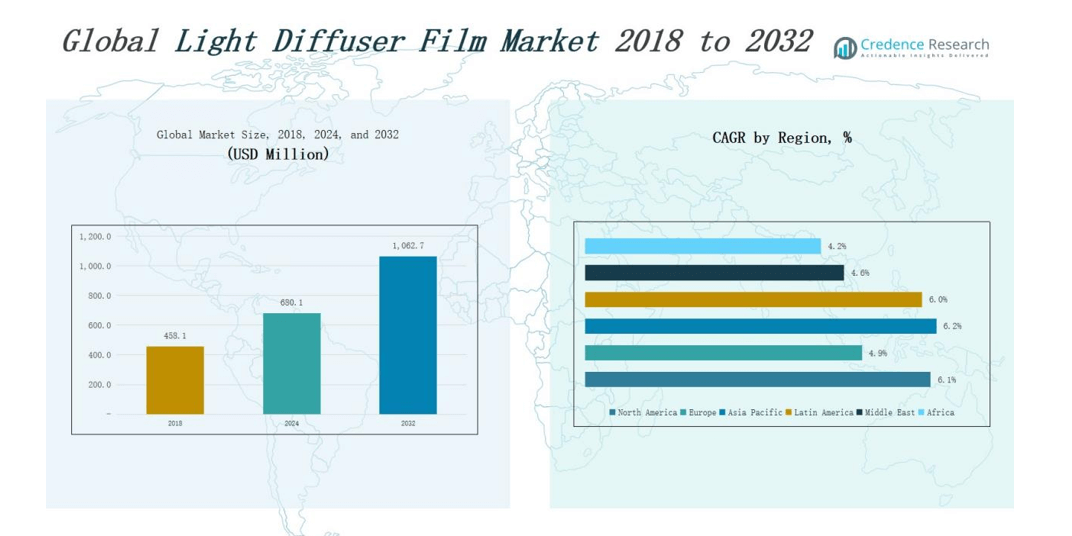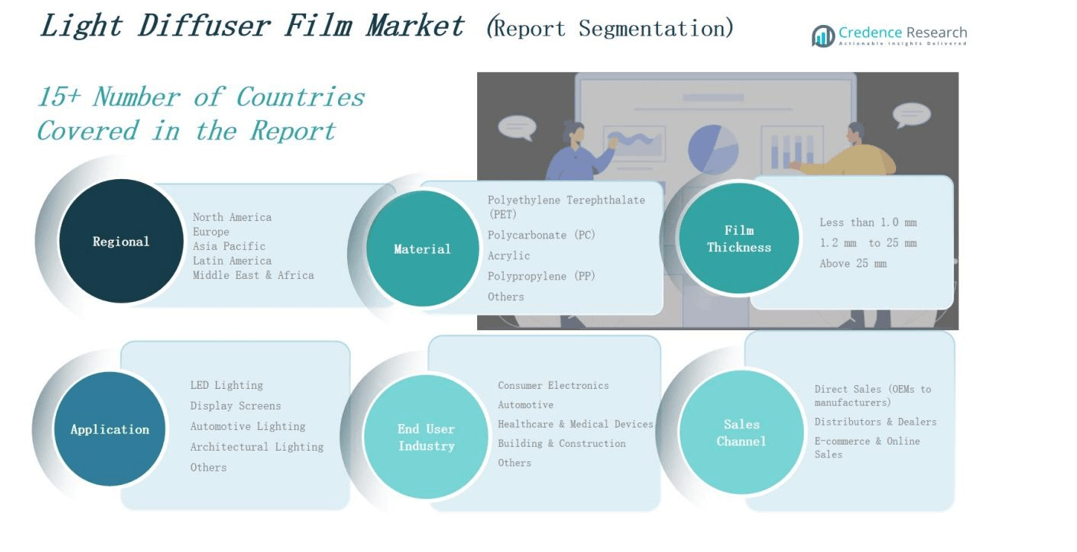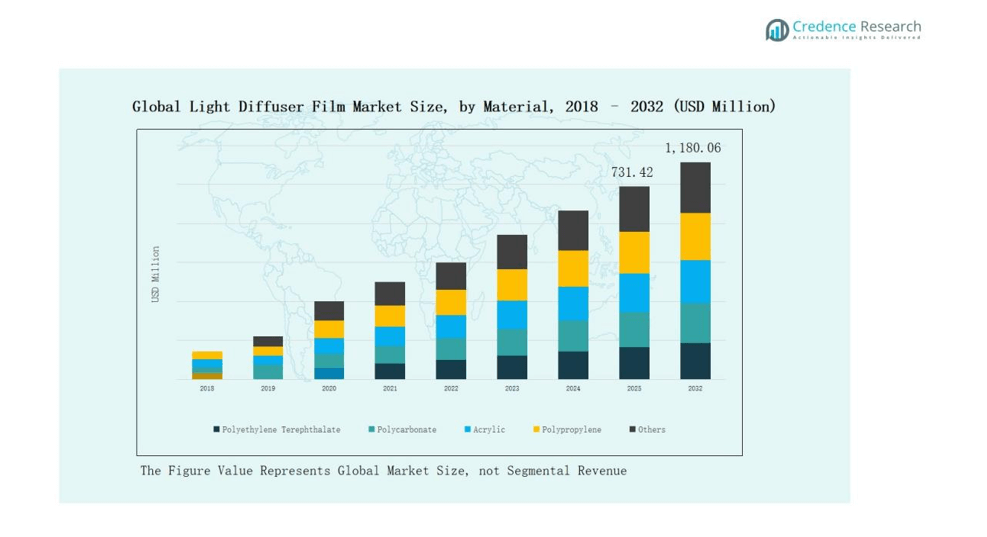CHAPTER NO. 1 : GENESIS OF THE MARKET
1.1 Market Prelude – Introduction & Scope
1.2 The Big Picture – Objectives & Vision
1.3 Strategic Edge – Unique Value Proposition
1.4 Stakeholder Compass – Key Beneficiaries
CHAPTER NO. 2 : EXECUTIVE LENS
2.1 Pulse of the Industry – Market Snapshot
2.2 Growth Arc – Revenue Projections (USD Million)
2.3. Premium Insights – Based on Primary Interviews
CHAPTER NO. 3 : LIGHT DIFFUSER FILM MARKET FORCES & INDUSTRY PULSE
3.1 Foundations of Change – Market Overview
3.2 Catalysts of Expansion – Key Market Drivers
3.2.1 Momentum Boosters – Growth Triggers
3.2.2 Innovation Fuel – Disruptive Technologies
3.3 Headwinds & Crosswinds – Market Restraints
3.3.1 Regulatory Tides – Compliance Challenges
3.3.2 Economic Frictions – Inflationary Pressures
3.4 Untapped Horizons – Growth Potential & Opportunities
3.5 Strategic Navigation – Industry Frameworks
3.5.1 Market Equilibrium – Porter’s Five Forces
3.5.2 Ecosystem Dynamics – Value Chain Analysis
3.5.3 Macro Forces – PESTEL Breakdown
3.6 Price Trend Analysis
3.6.1 Regional Price Trend
3.6.2 Price Trend by Material
CHAPTER NO. 4 : KEY INVESTMENT EPICENTER
4.1 Regional Goldmines – High-Growth Geographies
4.2 Product Frontiers – Lucrative Material Categories
4.3 Application Sweet Spots – Emerging Demand Segments
CHAPTER NO. 5: REVENUE TRAJECTORY & WEALTH MAPPING
5.1 Momentum Metrics – Forecast & Growth Curves
5.2 Regional Revenue Footprint – Market Share Insights
5.3 Segmental Wealth Flow – Material Type, Film Thickness, Application, End User & Sales Channel Revenue
CHAPTER NO. 6 : TRADE & COMMERCE ANALYSIS
6.1. Import Analysis by Region
6.1.1. Global Light Diffuser Film Market Import Revenue By Region
6.2. Export Analysis by Region
6.2.1. Global Light Diffuser Film Market Export Revenue By Region
CHAPTER NO. 7 : COMPETITION ANALYSIS
7.1. Company Market Share Analysis
7.1.1. Global Light Diffuser Film Market: Company Market Share
7.2. Global Light Diffuser Film Market Company Revenue Market Share
7.3. Strategic Developments
7.3.1. Acquisitions & Mergers
7.3.2. New Product Launch
7.3.3. Regional Expansion
7.4. Competitive Dashboard
7.5. Company Assessment Metrics, 2024
CHAPTER NO. 8 : LIGHT DIFFUSER FILM MARKET – BY MATERIAL TYPE SEGMENT ANALYSIS
8.1. Light Diffuser Film Market Overview By Material Type Segment
8.1.1. Light Diffuser Film Market Revenue Share By Material Type
8.2. Polyethylene Terephthalate (PET)
8.3. Polycarbonate (PC)
8.4. Acrylic
8.5. Polypropylene (PP)
8.6. Others
CHAPTER NO. 9 : Light Diffuser Film MARKET – BY FILM THICKNESS SEGMENT ANALYSIS
9.1. Light Diffuser Film Market Overview By Film Thickness Segment
9.1.1. Light Diffuser Film Market Revenue Share By Film Thickness
9.2. Less the 1.0 mm
9.3. 1.2 mm to 25 mm
9.4. Above 25 mm
CHAPTER NO. 10 : LIGHT DIFFUSER FILM MARKET – BY APPLICATION SEGMENT ANALYSIS
10.1. Light Diffuser Film Market Overview By Application Segment
10.1.1. Light Diffuser Film Market Revenue Share By Application
10.2. LED Lighting
10.3 Display Screens
10.4. Automotive Lighting
10.5. Architectural Lighting
10.6. Others
CHAPTER NO. 11 : LIGHT DIFFUSER FILM MARKET – BY END USER TYPE SEGMENT ANALYSIS
11.1. Light Diffuser Film Market Overview By End User Type Segment
11.1.1. Light Diffuser Film Market Revenue Share By End User Type
11.2. Consumer Electronics
11.3. Automotive
11.4. Healthcare & Medical Devices
11.5. Building & Construction
11.6. Others
CHAPTER NO. 12 : LIGHT DIFFUSER FILM MARKET – BY SALES CHANNEL SEGMENT ANALYSIS
12.1. Light Diffuser Film Market Overview By Sales Channel Segment
12.1.1. Light Diffuser Film Market Revenue Share By Sales Channel
12.2. Direct Sales (OEMs to manufacturers)
12.3. Distributors & Dealers
12.4. E-commerce & Online Sales
CHAPTER NO. 13 : LIGHT DIFFUSER FILM MARKET – REGIONAL ANALYSIS
13.1. Light Diffuser Film Market Overview by Region Segment
13.1.1. Global Light Diffuser Film Market Revenue Share By Region
13.1.2. Regions
13.1.3. Global Light Diffuser Film Market Revenue By Region
13.1.4. Material Type
13.1.5. Global Light Diffuser Film Market Revenue By Material Type
13.1.6. Application
13.1.7. Global Light Diffuser Film Market Revenue By Application
13.1.8. Film Thickness
13.1.9. Global Light Diffuser Film Market Revenue By Film Thickness
13.1.10. End User Type
13.1.12. Global Light Diffuser Film Market Revenue By End User Type
13.1.13. Sales Channel
13.1.14. Global Light Diffuser Film Market Revenue By Sales Channel
CHAPTER NO. 14 : NORTH AMERICA LIGHT DIFFUSER FILM MARKET – COUNTRY ANALYSIS
14.1. North America Light Diffuser Film Market Overview By Country Segment
14.1.1. North America Light Diffuser Film Market Revenue Share By Region
14.2. North America
14.2.1. North America Light Diffuser Film Market Revenue By Country
14.2.2. Material Type
14.2.3. North America Light Diffuser Film Market Revenue By Material Type
14.2.4. Application
14.2.5. North America Light Diffuser Film Market Revenue By Application
14.2.6. Film Thickness
14.2.7. North America Light Diffuser Film Market Revenue By Film Thickness
14.2.8. End User Type
14.2.9. North America Light Diffuser Film Market Revenue By End User Type
14.2.10. Sales Channel
14.2.11. North America Light Diffuser Film Market Revenue By Sales Channel
14.3. U.S.
14.4. Canada
14.5. Mexico
CHAPTER NO. 15 : EUROPE LIGHT DIFFUSER FILM MARKET – COUNTRY ANALYSIS
15.1. Europe Light Diffuser Film Market Overview By Country Segment
15.1.1. Europe Light Diffuser Film Market Revenue Share By Region
15.2. Europe
15.2.1. Europe Light Diffuser Film Market Revenue By Country
15.2.2. Material Type
15.2.3. Europe Light Diffuser Film Market Revenue By Material Type
15.2.4. Application
15.2.5. Europe Light Diffuser Film Market Revenue By Application
15.2.6. Film Thickness
15.2.7. Europe Light Diffuser Film Market Revenue By Film Thickness
15.2.8. End User Type
15.2.9. Europe Light Diffuser Film Market Revenue By End User Type
15.2.10. Sales Channel
15.2.11. Europe Light Diffuser Film Market Revenue By Sales Channel
15.3. UK
15.4. France
15.5. Germany
15.6. Italy
15.7. Spain
15.8. Russia
15.9. Rest of Europe
CHAPTER NO. 16 : ASIA PACIFIC LIGHT DIFFUSER FILM MARKET – COUNTRY ANALYSIS
16.1. Asia Pacific Light Diffuser Film Market Overview By Country Segment
16.1.1. Asia Pacific Light Diffuser Film Market Revenue Share By Region
16.2. Asia Pacific
16.2.1. Asia Pacific Light Diffuser Film Market Revenue By Country
16.2.2. Material Type
16.2.3. Asia Pacific Light Diffuser Film Market Revenue By Material Type
16.2.4. Application
16.2.5. Asia Pacific Light Diffuser Film Market Revenue By Application
16.2.6. Film Thickness
16.2.7. Asia Pacific Light Diffuser Film Market Revenue By Film Thickness
16.2.8. End User Type
16.2.9. Asia Pacific Light Diffuser Film Market Revenue By End User Type
16.2.10. Sales Channel
16.2.11. Asia Pacific Light Diffuser Film Market Revenue By Sales Channel
16.3. China
16.4. Japan
16.5. South Korea
16.6. India
16.7. Australia
16.8. Southeast Asia
16.9. Rest of Asia Pacific
CHAPTER NO. 17 : LATIN AMERICA LIGHT DIFFUSER FILM MARKET – COUNTRY ANALYSIS
17.1. Latin America Light Diffuser Film Market Overview By Country Segment
17.1.1. Latin America Light Diffuser Film Market Revenue Share By Region
17.2. Latin America
17.2.1. Latin America Light Diffuser Film Market Revenue By Country
17.2.2. Material Type
17.2.3. Latin America Light Diffuser Film Market Revenue By Material Type
17.2.4. Application
17.2.5. Latin America Light Diffuser Film Market Revenue By Application
17.2.6. Film Thickness
17.2.7. Latin America Light Diffuser Film Market Revenue By Film Thickness
17.2.8. End User Type
17.2.9. Latin America Light Diffuser Film Market Revenue By End User Type
17.2.10. Sales Channel
17.2.11. Latin America Light Diffuser Film Market Revenue By Sales Channel
17.3. Brazil
17.4. Argentina
17.5. Rest of Latin America
CHAPTER NO. 18 : MIDDLE EAST LIGHT DIFFUSER FILM MARKET – COUNTRY ANALYSIS
18.1. Middle East Light Diffuser Film Market Overview By Country Segment
18.1.1. Middle East Light Diffuser Film Market Revenue Share By Region
18.2. Middle East
18.2.1. Middle East Light Diffuser Film Market Revenue By Country
18.2.2. Material Type
18.2.3. Middle East Light Diffuser Film Market Revenue By Material Type
18.2.4. Application
18.2.5. Middle East Light Diffuser Film Market Revenue By Application
18.2.6. Film Thickness
18.2.7. Middle East Light Diffuser Film Market Revenue By Film Thickness
18.2.8. End User Type
18.2.9. Middle East Light Diffuser Film Market Revenue By End User Type
18.2.10. Sales Channel
18.2.11. Middle East Light Diffuser Film Market Revenue By Sales Channel
18.3. GCC Countries
18.4. Israel
18.5. Turkey
18.6. Rest of Middle East
CHAPTER NO. 19 : AFRICA LIGHT DIFFUSER FILM MARKET – COUNTRY ANALYSIS
19.1. Africa Light Diffuser Film Market Overview By Country Segment
19.1.1. Africa Light Diffuser Film Market Revenue Share By Region
19.2. Africa
19.2.1. Africa Light Diffuser Film Market Revenue By Country
19.2.2. Material Type
19.2.3. Africa Light Diffuser Film Market Revenue By Material Type
19.2.4. Application
19.2.5. Africa Light Diffuser Film Market Revenue By Application
19.2.6. Film Thickness
19.2.7. Africa Light Diffuser Film Market Revenue By Film Thickness
19.2.8. End User Type
19.2.9. Africa Light Diffuser Film Market Revenue By End User Type
19.2.10. Sales Channel
19.2.11. Africa Light Diffuser Film Market Revenue By Sales Channel
19.3. South Africa
19.4. Egypt
19.5. Rest of Africa
CHAPTER NO. 20 : COMPANY PROFILES
20.1. 3M
20.1.1. Company Overview
20.1.2. Material Portfolio
20.1.3. Financial Overview
20.1.4. Recent Developments
20.1.5. Growth Strategy
20.1.6. SWOT Analysis
20.2. Yongtek
20.3. Tilara Polyplast Private Limited
20.4. Sun Acrylam Private Limited
20.5. LINTEC Corporation
20.6. KEIWA INCOPORATED
20.7. Luminit, Inc.
20.8. König Folienzentrum
20.9. Ingemann Components A/S
20.10. LG Chem
20.11. Plextrusion India LLP
20.12. Kimoto
20.13. Other Key Players










